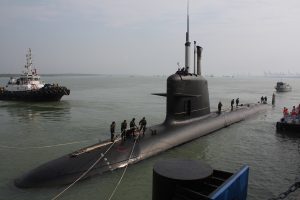France’s Naval Group recently announced that Indonesia had signed a contract to purchase two Scorpene submarines, which a lithium-ion battery system will power in a deal valued at around $2 billion. The most interesting part to me is that both submarines will be built in Indonesia by state-owned shipbuilder PT PAL at its facility in Surabaya.
This deal has been in the works for a while, and it helps consolidate the increasingly close defense ties between France and Indonesia. French aerospace firm Dassault is already in the middle of an $8 billion contract to deliver 42 Rafale fighter jets to the Indonesian Air Force, with the first planes set to arrive in two years. And Thales, a French technology company, is co-developing radar and other electronic systems with Indonesian defense firm PT Len. But the Scorpene deal represents a big, and risky, step forward.
As an archipelagic nation covering a large maritime territory, some of which is increasingly entangled in geopolitical tensions, Indonesia undoubtedly needs a submarine fleet. In 2011, the country signed a deal to buy three Jang Bogo-class submarines from South Korea’s Daewoo Shipbuilding & Marine Engineering for about $1 billion. The first two were built in Korea but the third was assembled by PT PAL in Surabaya and went into service in 2019. Involving an Indonesian shipyard in co-production was a big selling point for the deal.
Indonesia was reportedly unhappy with the South Korean subs, and plans to procure three more were scrapped. The Indonesian government, however, never gave up on its ambitions and clearly wanted to continue the submarine program in some form. A big priority was to acquire more domestic production capabilities through transfers of technology, and infrastructure for the production of submarines was built at PT PAL’s shipyard in Surabaya.
It has been pretty obvious that this Scorpene deal was in the works, as Naval Group already has a well-established footprint in the region and is frequently willing to give customers what they really want, which is production. In the early 2000s, Naval Group delivered a pair of Scorpene submarines to the Malaysian navy, which are currently in operation. In 2005, India purchased six Scorpenes for $3 billion. The submarines were produced by an Indian shipyard in Mumbai under a technology transfer deal. Naval Group did a similar deal with Brazil, except that one also involves development of a nuclear submarine. The third submarine produced under this arrangement was launched last month.
It was this willingness by Naval Group (and French defense contractors generally) to share technology and production that made this an appealing deal for Indonesia. Both Scorpene subs will be produced by PT PAL in Surabaya, where the state-owned shipbuilder is also currently building a pair of Arrowhead 140 frigates under license from the U.K.’s Babcock. If everything goes as planned this would represent a significant increase in production capabilities for PT PAL by the end of the decade.
But there are risks. The major one is that Indonesia’s Scorpenes plan to use a lithium ion battery system, which will allow the subs to operate submerged for longer periods. But lithium ion batteries in submarines are relatively new. As far as I know, Naval Group has never done this before with a Scorpene which means Indonesia will more or less be the test case for the new battery system. There is a good chance the program will be more costly and complicated than initially envisioned as they work out the kinks in the production process and with the batteries.
Clearly, this is a risk the Indonesian government is willing to take. This is especially true because Indonesia is really into batteries these days, attempting to position itself as a global battery production hub for clean energy supply chains. Localizing production of the two Scorpene subs in Surabaya while co-developing the lithium ion battery technology is something that fits Indonesia’s strategic and military requirements, as well as its economic development goals.
On the other hand, it’s important not to downplay the risk. In 2011, Malaysia started building six littoral combat ships in a local shipyard under license from Naval Group. To date, not a single ship has been delivered and the state-owned firm building the ships has basically gone bankrupt causing a bunch of collateral damage in the process. For Indonesia and PT PAL, there is a lot to be gained if the Scorpene program goes according to plan but also a lot to lose if it goes the way of the Malaysian LCS program.

































